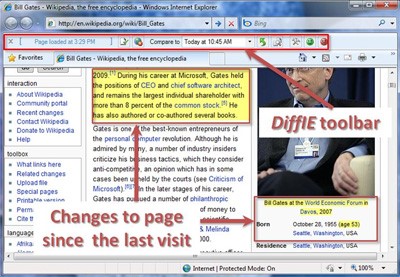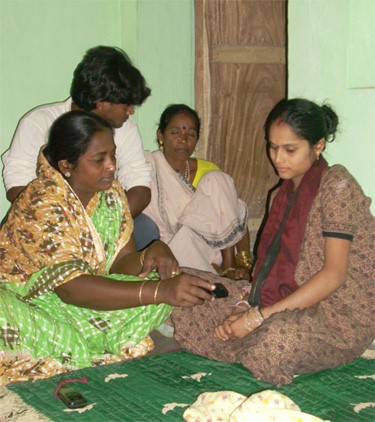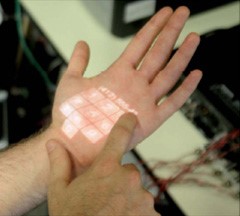By Janie Chang, Writer, Microsoft Research
One glance at the list of topics featured in the CHI 2010 Technical Program is all it takes to understand the diversity of research disciplines that contribute to the field of human-computer interaction (HCI). CHI 2010, the Association for Computing Machinery’s Conference on Human Factors in Computing Systems, brings top HCI researchers to Atlanta from April 10 to 15 for six busy days of presentations, panels, exhibits, and discussions.
CHI challenges participants to advance HCI research with work that supports the diversity of human experiences in computing and empowers people from all walks of life. As a result, the technical papers featured during the conference represent a fascinating mix of approaches that range from new input/output methods, to user behaviors, to applications for specific environments. With nearly 1,000 submissions, review committees had the difficult task of accepting just 365 for presentation. The number of submissions is an indication not only of lively interest in this field, but also the variety of issues that form this area of study.
Spotlight: Event Series
Microsoft has been involved actively in CHI conferences, both as sponsor and contributor. This year, 38 technical papers submitted by Microsoft Research were accepted by the conference, representing 10 percent of the papers accepted. Three of the Microsoft Research papers, covering vastly different topics, won Best Paper awards, and seven others received Best Paper nominations.
Best Papers Highlight HCI Diversity
A Longitudinal Study of How Highlighting Web Content Change Affects People’s Web Interactions, by Jaime Teevan, Susan T. Dumais, and Daniel J. Liebling of Microsoft Research Redmond, explores a dynamic approach to viewing Web pages. Teevan also shared the results of this study in a talk at Stanford University in December 2009.
Digital information, especially Web pages, changes quickly and regularly. As a general rule, every year the Web doubles in size and half the existing Web content changes. At the same time, capturing data about change in digital-information artifacts is easy compared with traditional formats, yet existing tools do little to capture, store, or make use of dynamic history.
“Web browsers show Web pages only as they currently appear,” Teevan explains. “And search engines only index pages as seen at the time they were crawled. We started studying Web-content change to learn more about how we could best take advantage of changing information.”
The research team formed a study involving 30 participants and a browser plug-in called DiffIE, an internal tool not publically available. Developed during one of Teevan’s earlier projects, DiffIE caches pages visited by the user, then, when the user returns to a previously viewed page, highlights changes that have occurred. While there have been other tools designed to track changes to Web sites, this was the first to highlight changes so that the user is constantly aware of new content during normal Web interactions. DiffIE made it possible for Teevan and her team to conduct a study to determine how user interactions with dynamic content might change through consistent awareness of Web-content change.
In the study, the researchers asked participants to answer the same set of questions before, and one month after, installing DiffIE. The survey questions were designed to elicit information about:
- How valuable participants expected the DiffIE tool to be, and what they found once they used it.
- Their perception of revisitationpatterns, including how often they revisit Web pages and how often they revisit Web pages to see new content.
- Their perception of how the pages they visit change, including what proportion of Web pages they revisit change, how often they notice unexpected changes, and how often various types of pages change.

The DiffIE toolbar highlights Web content that has changed since the user’s last page visit.
The researchers also captured free-form responses from participants commenting on the positive and negative aspects of the using the tool. In addition, 17 of the 30 participants allowed their interactions with DiffIE to be logged, yielding data on approximately 25,000 page visits.
The researchers expected users to find DiffIE most useful when it exposed changes people might be seeking, such as changes to news pages, stock quotes, or weather reports. But as it turned out, many Web sites with this kind of information already deliver dynamic content well. For example, a financial site is designed to help users notice when a stock price changes. The team found instead that with DiffIE, participants were using and understanding Web content in unanticipated new ways.
“It was somewhat surprising to us,” Teevan says, “that exposing change seemed to motivate people to revisit Web pages more and, in particular, to revisit those pages that change more often. For example, the number of comments a blog post receives isn’t normally particularly useful information. But if a person is interested in comments and can easily see changes, they might start refreshing pages more often to monitor for new comments.”
In ranking the value of seeing explicit content changes, the most valuable scenario was viewing unexpected but important changes. One user commented that seeing house-price changes on a real-estate site was “really useful.” Another valuable scenario was being able to see expected changes to Web content, such as a news site, and being able to avoid re-reading content. Also valuable was the ability to spot edits to fairly static pages, such as changes on a wiki.
Participants also found themselves making use of Web pages in new ways once they could see content change on a consistent basis. Participants were able to group blocks of content based on common change patterns and found activity counters—counters of thread views or new comments—more useful once they could see change.
For Teevan, user excitement over DiffIE has been one of the most gratifying aspects of this project. Participants have made many suggestions for expanding its functionality, such as being able to subscribe via RSS to changes on a page or configuring a mobile device to display only content changes.
The DiffIE team is busy exploring other ways to make use of change data. Improving search-engine functionality immediately springs to mind. Sometimes user queries target the static content of a page, and sometimes the user wants dynamic, real-time information. As an example, fans of a rock band normally search for the band’s Web page, fan-club pages, or a Twitter page; in this case, the band’s name would appear in every version of those pages. But when the group does something unusual, such as touring India to give free concerts, fans will want news articles or blog posts for up-to-the-minute information. In such a scenario, the band’s name would only appear in the current version of that news page or blog.
“Knowing how the page changes,” Teevan says, “and, specifically, how terms come and go from the page, can help improve search-engine ranking. We can make use of the fact that some terms appear in all time slices of a page, while others appear in only a few time slices.”
Facilitating Health Services in Rural India
An inspiring project that illustrates the societal impact of communications in rural communities is the subject of Mobile-izing Health Workers in Rural India by Divya Ramachandran and John Canny of the University of California, Berkeley; Prabhu Dutta Das of India’s Dhirubhai Ambani Institute of Information and Communications Technology; and Edward Cutrell of Microsoft Research India.

A rural maternal-health worker shows a mobile-phone video to her patient.
Projects for information and communication technologies (ICT) in developing countries face highly stratified power structures, traditional roles and practices that have not changed in centuries, and suspicion of outsiders and government. Such societies naturally resist the new practices required to make best use of new technologies. Instead, the team investigated the potential of ICTs as persuasion and motivation tools for facilitating new practices. After two months of intensive interviews and field work examining the rural maternal-health program of selected locations, the team designed an intervention program based on videos created and played on mobile phones. The program goal was to improve the effectiveness of female healthcare workers, who often have a difficult time persuading pregnant women to utilize health services.
They found that when health workers used or created their own educational videos, all stakeholders in the system became more engaged, and pregnant women became more receptive to using health services. With coaching, health workers found that videos facilitated discussions with patients and that health workers also were motivated by the fun of making and showing a video. Most surprising, health workers were able to recruit influential individuals in a village to participate in the video. As a result, those videos were quite persuasive when shown to patients. The team is examining ways to archive videos and create a health-worker community portal for sharing videos.
Human-Body User Interface

A sensing armband and a pico projector enable interactive elements to be rendered onto a person’s skin.
An input/output method that has generated a lot of attention and a well-publicized video is the technology described in Skinput: Appropriating the Body as an Input Surface by Chris Harrison of Carnegie Mellon University along with Desney Tan and Dan Morris of Microsoft Research Redmond.
The body is portable and always available, and fingers are a natural input device. Skinput is bio-acoustic technology that makes use of the human body as an input surface, enabling the location and vibration of finger taps on hands and arms to be analyzed and used as signals. The paper documents the technology, as well as the capabilities, accuracy, and limitations of the approach, as tested in a 20-participant study.
Microsoft Research Contributions to CHI 2010
These projects illustrate the wide range of disciplines active within the HCI community, as well as the diverse nature of HCI work within Microsoft Research, as evidenced by the papers it contributed to CHI 2010:
Technical papers authored or co-authored by Microsoft Research personnel that received CHI 2010 Best Paper awards:
A Longitudinal Study of How Highlighting Web Content Change Affects People’s Web Interactions by Jaime Teevan, Microsoft Research Redmond; Susan T. Dumais, Microsoft Research Redmond; and Daniel J. Liebling, Microsoft Research Redmond.
Mobile-izing Health Workers in Rural India by Divya Ramachandran, University of California, Berkeley; John Canny, University of California, Berkeley; Prabhu Dutta Das, Dhirubhai Ambani Institute of Information and Communications Technology; and Edward Cutrell, Microsoft Research India.
Skinput: Appropriating the Body as an Input Surface by Chris Harrison, Carnegie Mellon University; Desney Tan, Microsoft Research Redmond; and Dan Morris, Microsoft Research Redmond.
Other technical papers authored or co-authored by Microsoft Research personnel that were nominated for CHI 2010 Best Paper awards:
Designing a Technological Playground: A Field Study of the Emergence of Play in Household Messaging by Siân E. Lindley, Microsoft Research Cambridge; Richard Harper, Microsoft Research Cambridge; and Abigail Sellen, Microsoft Research Cambridge.
Designing Patient-Centric Information Displays for Hospitals by Lauren Wilcox, Columbia University; Dan Morris, Microsoft Research Redmond; Desney Tan, Microsoft Research Redmond; and Justin Gatewood, Washington Hospital Center.
Evaluating Cues for Resuming Interrupted Programming Tasks by Chris Parnin, Georgia Institute of Technology, and Robert DeLine, Microsoft Research Redmond.
Intermediated Technology Use in Developing Communities by Nithya Sambasivan, University of California, Irvine; Ed Cutrell, Microsoft Research India; Kentaro Toyama, University of California, Berkeley; and Bonnie Nardi, University of California, Irvine.
LensMouse: Augmenting the Mouse with an Interactive Touch Display by Xing Dong Yang, University of Alberta; Edward Mak, University of Manitoba; David McCallum, University of Manitoba; Pourang Irani, University of Manitoba; Xiang Cao, Microsoft Research Cambridge; and Shahram Izadi, Microsoft Research Cambridge
Passing On & Putting to Rest: Understanding Bereavement in the Context of Interactive Technologies by William Odom, Carnegie Mellon University; Richard Harper, Microsoft Research Cambridge; Abigail Sellen, Microsoft Research Cambridge; David Kirk, University of Nottingham; and Richard Banks, Microsoft Research Cambridge.
What’s Your Idea? A Case Study of a Grassroots Innovation Pipeline Within a Large Software Company by Brian P. Bailey, University of Illinois; and Eric Horvitz, Microsoft Research Redmond.
Other technical papers authored or co-authored by Microsoft Research personnel that have been accepted for presentation during CHI 2010:
A Comparative Evaluation on Tree Visualization Methods for Hierarchical Structures with Large Fan-outs by Hyunjoo Song, Seoul National University; Bohyoung Kim, Seoul National University; and Bongshin Lee, Microsoft Research Redmond.
A Strategy-Centric Approach to the Design of End-User Debugging Tools by Valentina I. Grigoreanu, Microsoft; Margaret M. Burnett, Oregon State University; and George G. Robertson, Microsoft Research Redmond.
After Access – Challenges Facing Mobile-Only Internet Users in the Developing World by Shikoh Gitau, University of Cape Town; Gary Marsden, University of Cape Town; and Jonathan Donner, Microsoft Research India.
Cars, Calls, and Cognition: Investigating Driving and Divided Attention by Shamsi T. Iqbal, Microsoft Research Redmond; Yun-Cheng Ju, Microsoft Research Redmond; and Eric Horvitz, Microsoft Research Redmond.
Comparing User Performance with Single-Finger, Whole-Hand, and Hybrid Pointing Devices by Xiang Cao, Microsoft Research Cambridge; Nicolas Villar, Microsoft Research Cambridge; and Shahram Izadi, Microsoft Research Cambridge.
Embodied Social Proxy: Mediating Interpersonal Connection in Hub-and-Satellite Teams by Gina Venolia, Microsoft Research Redmond; John Tang, Microsoft Research Redmond; Ruy Cervantes, University of California, Irvine; Sara Bly, Sara Bly Consulting; George Robertson, Microsoft Research Redmond; Bongshin Lee, Microsoft Research Redmond; and Kori Inkpen, Microsoft Research Redmond.
Examining Multiple Potential Models in End-User Interactive Concept Learning by Saleema Amershi, University of Washington; James Fogarty, University of Washington; Ashish Kapoor, Microsoft Research Redmond; and Desney Tan, Microsoft Research Redmond.
Experience in Social Affective Applications: Methodologies and Case Study by Paul André, University of Southampton; m.c. schraefel, University of Southampton; Alan Dix, Lancaster University; and Ryen W. White, Microsoft Research Redmond.
FM Radio: Family Interplay with Sonic Mementos by Daniela Petrelli, University of Sheffield; Nicolas Villar, Microsoft Research Cambridge; Vaiva Kalnikaitė, University of Sheffield; Lina Dib, Rice University; and Steve Whittaker, University of Sheffield.
FrameWire: A Tool for Automatically Extracting Interaction Logic from Paper Prototyping Tests by Yang Li, University of Washington; Xiang Cao, Microsoft Research Cambridge; Katherine Everitt, University of Washington; Morgan Dixon, University of Washington; and James Landay, University of Washington.
Graspables Revisited: Multi-Touch vs. Tangible Input for Tabletop Displays in Acquisition and Manipulation Tasks by Philip Tuddenham, University of Cambridge; David Kirk, University of Nottingham; and Shahram Izadi, Microsoft Research Cambridge.
Hard-to-Use Interfaces Considered Beneficial (Some of the Time) by Yann Riche, Riche Design; Nathalie Henry Riche, Microsoft Research Redmond; Petra Isenberg, University of Calgary; and Anastasia Bezerianos, École Centrale Paris.
Hidden Markets: UI Design for a P2P Backup Application by Sven Seuken, Harvard University; Kamal Jain, Microsoft Research Redmond; Desney Tan, Microsoft Research Redmond; and Mary Czerwinski, Microsoft Research Redmond.
Interactive Optimization for Steering Machine Classification by Ashish Kapoor, Microsoft Research Redmond; Bongshin Lee, Microsoft Research Redmond; Desney Tan, Microsoft Research Redmond; and Eric Horvitz, Microsoft Research Redmond.
Making Muscle-Computer Interfaces More Practical by T. Scott Saponas, University of Washington; Desney S. Tan, Microsoft Research Redmond; Dan Morris, Microsoft Research Redmond; Jim Turner, Microsoft; and James A. Landay, University of Washington.
Manual Deskterity: An Exploration of Simultaneous Pen + Touch Direct Input by Ken Hinckley, Microsoft Research Redmond; Koji Yatani, University of Toronto; Michel Pahud, Microsoft Research Redmond; Nicole Coddington, Microsoft; Jenny Rodenhouse, Microsoft; Hrvoje Benko, Microsoft Research Redmond; Andy Wilson, Microsoft Research Redmond; and Bill Buxton, Microsoft Research Redmond.
Mobile Taskflow in Context: A Screenshot Study of Smartphone Usage by Amy K. Karlson, Microsoft Research Redmond; Shamsi T. Iqbal, Microsoft Research Redmond; Brian Meyers, Microsoft Research Redmond; Gonzalo Ramos, Microsoft; Kathy Lee, Microsoft; and John C. Tang, Microsoft Research Redmond.
Newport: Enabling Sharing During Mobile Calls by Junius A. Gunaratne, University of California, Irvine; and A.J. Bernheim Brush, Microsoft Research Redmond.
Now Let Me See Where I Was: Understanding How Lifelogs Mediate Memory by Vaiva Kalnikaitė, University of Sheffield; Abigail Sellen, Microsoft Research Cambridge; Steve Whittaker, IBM Research – Almaden; and David Kirk, University of Nottingham.
Planz to Put Our Digital Information in Its Place by William Jones, University of Washington; Dawei Hou, University of Washington; Bhuricha Deen Sethanandha, Portland State University; Eric Sheng Bi, University of Washington; and Jim Gemmell, Microsoft Research Silicon Valley.
Potential for Personalization by Jaime Teevan, Microsoft Research Redmond; Susan T. Dumais, Microsoft Research Redmond; and Eric Horvitz, Microsoft Research Redmond.
”The Calendar is Crucial”: Coordination and Awareness Through the Family Calendar by Carman Neustaedter, University of Calgary; A.J. Bernheim Brush, Microsoft Research Redmond; and Saul Greenberg, University of Calgary.
Touch-Display Keyboards: Transforming Keyboards into Interactive Surfaces by Florian Block, Lancaster University; Hans Gellersen, Lancaster University; and Nicolas Villar, Microsoft Research Cambridge.
Video Playdate: Toward Free Play Across Distance by Svetlana Yarosh, Georgia Institute of Technology; Kori M. Inkpen, Microsoft Research Redmond; and A.J. Bernheim Brush, Microsoft Research Redmond.
ViralVCD: Tracing Information-Diffusion Paths with Low Cost Media in Developing Communities by Nithya Sambasivan, University of California, Irvine; Ed Cutrell, Microsoft Research India; and Kentaro Toyama, University of California, Berkeley.
What Do People Ask Their Social Networks, and Why? A Survey Study of Status Message Q&A Behavior by Meredith Ringel Morris, Microsoft Research Redmond; Jaime Teevan, Microsoft Research Redmond; and Katrina Panovich, Massachusetts Institute of Technology.
Where There’s a Will There’s a Way: Mobile Media Sharing in Urban India by Thomas N. Smyth, Georgia Institute of Technology; Satish Kumar, Microsoft Research India; Indrani Medhi, Microsoft Research India; and Kentaro Toyama, University of California, Berkeley.
Who’s Hogging the Bandwidth: The Consequences of Revealing the Invisible in the Home by Marshini Chetty, Georgia Institute of Technology; Richard Banks, Microsoft Research Cambridge; Richard Harper, Microsoft Research Cambridge; Tim Regan, Microsoft Research Cambridge; Abigail Sellen, Microsoft Research Cambridge; Christos Gkantsidis, Microsoft Research Cambridge; Thomas Karagiannis, Microsoft Research Cambridge; and Peter Key, Microsoft Research Cambridge.




